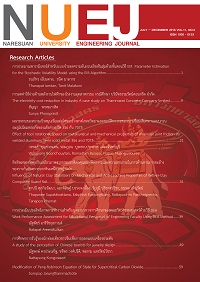Works Performance Assessment of Educational Personnel Using DEA Method
Main Article Content
Abstract
– Work performance assessment of educational personnel is a complex task stem from variety of related criteria such as total number of students enrolled, published research manuscripts, research funding, and other criteria which summarized from literature review. Based on these criteria, the management team of the case study organization selects the most appropriate criteria consisted of 2 input criteria and 7 output criteria. These are 1) monthly salary 2) total expense including educational equipment 3) published research papers score referred to MUA standard 4) % advisees remain in program 5) GPAX of all advisees 6) research funding and academic services income 7) teaching load 8) average income from enrollment and 9) competition reward. Then, all the necessary data of 30 personnel is collected to formulate linear programming models for DEA method and each model is solved by using Excel’s solver. The result shows that the personnel can be divided into 4 groups based on performance index score interval which are the best performance group and the other three lower score groups. The best performance group is then used as the standard to inspire other groups to conduct self-development. Moreover, the obtained performance index score is used to design the 5 years competency development plan and annual performance assessment for each personnel.
Article Details
References
Abd Aziz, N., Janor, R.M., & Mahadi, R.(2013). Comparative departmental efficiency analysis within a university: a DEA approach. Procedia. Social and Behavioral Sciences, 90, 540–548.
Agasisti,T., & DalBianco, A.(2009). Measuring efficiency of higher education institu-tions. International Journal of Management and Decision Making, 10(5-6), 443–465.
Avilés, S., Güemes, D., Cook,W. , &Cantú , H. (2015). Time-staged outputs in DEA. Omega, 55, 1–9.
Charnes, A., Cooper, .W., &Rhodes, E. (1978). Measuring the efficiency of decision making units. European Journal of Operational Research, 2, 429–444.
Chang,T., Chung,P., &Hsu,S. (2012). Two-stage performance model for evaluating the managerial efficiency of higher education: application by the Taiwanese tourism and leisure department. Journal of Hospitality, Leisure, Sport & Tourism Education, 11, 168–177.
García Aracil, A.,López Iñesta, E.,&Palomares, D.(2009). Ananalysis of the Spain public universities missions in efficiency terms. In: Roig, J.M.and Vila, L.E.(coord.), Inves-tigaciones de economía de la educación, XVIII Jornadas de la Asociación Económica de la Educación,Valencia, España, 293–302.
Montoneri,B. , Lee,C.C. , Lin,T.T., &Huang,S.L. (2011). A learning performance evaluation with benchmarking concept for English writing courses.
Expert Systems with Applications, 38(12), 14542-14549.
Montoneri,B., Lee,C.C., Lin,T.T., &Huang,S.L. (2012). Application of data envelopment analysis on the indicators contributing to learning and teaching performance. Teaching and Teacher Education, 28(3), 382–395.
Subhasg C. Ray (2004). Data Envelopment Analysis: Theory and Techniques for Economics and Operations Research, Cambridge University Press, The Edinburgh Building, Cambridge, UK.
Ramón Fuentes, Begoña Fuster, Adelaida Lillo-Bañuls, (2016). A three-stage DEA model to evaluate learning-teaching technical efficiency: Key performance indicators and contextual variables. Expert Systems with Applications, 48(2016), 89–99.


